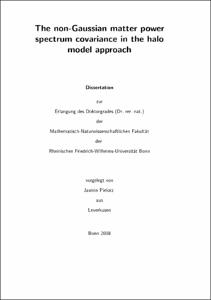The non-Gaussian matter power spectrum covariance in the halo model approach


| dc.contributor.advisor | Schneider, Peter | |
| dc.contributor.author | Pielorz, Jasmin | |
| dc.date.accessioned | 2020-04-12T16:46:07Z | |
| dc.date.available | 2020-04-12T16:46:07Z | |
| dc.date.issued | 2008 | |
| dc.identifier.uri | https://hdl.handle.net/20.500.11811/3658 | |
| dc.description.abstract | Weak gravitational lensing is one of the most promising tools to analyze the nature of dark energy and dark matter. In order to constrain cosmological parameters with this method a good theoretical understanding of the underlying dark matter density field is necessary. This work provides an analytical treatment of higher-order correlation functions in the dark matter density field and compares the results obtained with numerical N-body simulations. The tool of choice is a semi-analytic halo model which combines results from perturbation theory and N-body simulations. The main emphasis of this work is on the fourth-order correlation function and its Fourier counterpart, the trispectrum, since it allows us to study the non-Gaussianities of the dark matter field and to calculate the full non-Gaussian covariance of the power spectrum. This provides a way to estimate the error and mode coupling in the dark matter power spectrum to higher accuracy than has been previously. | en |
| dc.language.iso | eng | |
| dc.rights | In Copyright | |
| dc.rights.uri | http://rightsstatements.org/vocab/InC/1.0/ | |
| dc.subject | Kosmologie | |
| dc.subject | Strukturbildung | |
| dc.subject | N-body-Simulationen | |
| dc.subject | Dunkle Materie | |
| dc.subject | Kovarianz | |
| dc.subject | Leistungsspektrum | |
| dc.subject | cosmology | |
| dc.subject | structure formation | |
| dc.subject | Halo Model | |
| dc.subject | N-body simulations | |
| dc.subject | dark matter | |
| dc.subject | covariance | |
| dc.subject | power spectrum | |
| dc.subject.ddc | 520 Astronomie, Kartografie | |
| dc.title | The non-Gaussian matter power spectrum covariance in the halo model approach | |
| dc.type | Dissertation oder Habilitation | |
| dc.publisher.name | Universitäts- und Landesbibliothek Bonn | |
| dc.publisher.location | Bonn | |
| dc.rights.accessRights | openAccess | |
| dc.identifier.urn | https://nbn-resolving.org/urn:nbn:de:hbz:5N-14952 | |
| ulbbn.pubtype | Erstveröffentlichung | |
| ulbbnediss.affiliation.name | Rheinische Friedrich-Wilhelms-Universität Bonn | |
| ulbbnediss.affiliation.location | Bonn | |
| ulbbnediss.thesis.level | Dissertation | |
| ulbbnediss.dissID | 1495 | |
| ulbbnediss.date.accepted | 11.07.2008 | |
| ulbbnediss.fakultaet | Mathematisch-Naturwissenschaftliche Fakultät | |
| dc.contributor.coReferee | Porciani, Cristiano |
Files in this item
This item appears in the following Collection(s)
-
E-Dissertationen (4337)




